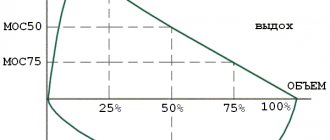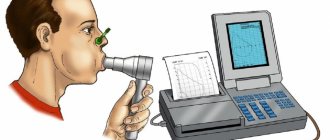What is peak flowmetry and why is it needed?
Many patients suffering from chronic non-pulmonary diseases have equipment that helps them monitor certain indicators (pulse rate, blood pressure, blood sugar level). Depending on their values, a person can control their treatment. People with high blood pressure always have a blood pressure monitor at home, and people with diabetes always have a glucometer. What should a person suffering from bronchial asthma do? How can he control his condition? You can, of course, rely on your own feelings, but this is not reliable. More frequent attacks of difficulty breathing, worsening cough, worsening shortness of breath. A person begins to notice all these signs of exacerbation of bronchial asthma when the exacerbation is in full swing and its treatment requires great effort and a significant increase in drug doses.
There is an exit. For people suffering from bronchial asthma, a simple device has been invented that helps monitor the condition of the bronchi and take the necessary measures in time. This means starting treatment earlier with smaller doses of medications and preventing the development of a severe exacerbation. This is the same graduated tube that we talked about, which is called a peak flow meter.
The peak flow meter shows the highest speed at which air can pass through the respiratory tract during a maximum exhalation. This means that it allows you to assess the degree of narrowing of the bronchi and the degree of their expansion when taking medications.
Peak flowmetry is a method of self-monitoring of the course of bronchial asthma.
1.General information
In pulmonology, many techniques are practiced that allow one to assess the state of the respiratory organs in the simplest and shortest way: by measuring various characteristics of inhalation and exhalation. Such functional tests also include peak flowmetry, a method that has become widespread in recent years due to its combination of information content and simplicity.
Sometimes you can hear an apt aphorism: “The most difficult thing about peak flowmetry is its name.” Indeed, the term in Russian looks somewhat cumbersome, but in the original English it sounds quite natural; it is formed from the words “peak” (peak, maximum, highest point) and “flow” (flow, in this context - exhalation). Thus, peak flowmetry is an instrumental measurement of the maximum possible speed of exhaled air flow for a given patient.
A must read! Help with hospitalization and treatment!
How is peak flowmetry performed correctly?
Peak flowmetry is performed twice a day: in the morning immediately after getting out of bed before taking medications and in the evening before bed.
- Set the peak flow meter scale slider to zero.
- Place your lips tightly around the mouthpiece
- Do not block the ventilation openings on the back of the appliance with your hand.
- Take a calm breath and exhale as strongly and sharply as quickly as possible.
- Move the slider back and repeat these steps two more times
- Record the best of the three values in your journal.
Peak flow meter - what is it and how to use it for allergies and bronchial asthma?
Breathing pathologies lead to severe disorders throughout the body. This occurs due to a lack of oxygen and excess carbon dioxide. Serious respiratory dysfunction is observed in chronic diseases of the lungs and bronchi. In addition, other pathologies can lead to hypoxia. Among them are laryngospasm, enlargement of the tonsils of the 2nd and 3rd degree with tonsillitis, entry of a foreign body into the respiratory tract, etc.
To distinguish between diseases, various research methods are used. One of them is peak flowmetry. This diagnostic procedure is performed if bronchial asthma, chronic obstructive pulmonary disease, or emphysema are suspected. People suffering from these pathologies know firsthand about such a device as a peak flow meter. What it is and how to use it should be explained by your doctor. Treatment tactics depend on the indicators of this device.
Peak flow meter - what is it?
As is known, the main method for determining respiratory functions is spirometry. However, the device needed for this study is quite expensive and is only available in the clinic. So that patients could measure their breathing parameters at home, a more convenient device was invented - a peak flow meter. Every patient suffering from bronchial asthma and COPD knows what it is. After all, such diseases are pathologies that require constant monitoring of the condition. This is especially true for patients with an established diagnosis of moderate and severe severity. Thanks to peak flowmetry, the stage of the disease can be determined. After all, the severity level is set based on an indicator such as peak expiratory flow (PEF). A peak flow meter is a portable device that every patient has. It can be used to measure PEF both during attacks and at rest. Thanks to the peak flow meter, the disease is controlled. If there are changes in the readings of this device, you should consult a doctor to adjust the treatment.
Operating principle of a peak flow meter
The action of the peak flow meter is based on the movement of the needle when pressure is applied to it by the air flow. The device has a scale from 0 to 1000. It is used to determine how much air the patient can exhale in 1 minute. In this way, the vital capacity of the lungs can be approximately calculated. A mouthpiece is attached to the device. It is into this that the patient exhales. In addition to the numbers, the device has colored markings. They are necessary to assess the state of respiratory function.
Despite the fact that the principle of operation of the peak flow meter is quite simple, in some cases errors are noted when using it. More often this applies to pediatric patients, who need to be explained exactly how to exhale. To make it clear to the child, he is told to blow as if extinguishing the candles on a cake. Regardless of the patient’s age, all patients suffering from bronchial asthma must attend special classes organized at the clinic. Thanks to them, people learn about the correct lifestyle, types of medications and indications for their use. Why a peak flow meter is needed, what it is and how to use it is also explained here. Patients are also informed about the target values of this device and pronounced deviations from the norm.
Types of peak flow meters: differences
A peak flow meter is an instrument for measuring expiratory flow that was created in the 1950s by Professor Wright. This device had the same mechanism of action as the modern device, but was larger in size. In 1975, the device was improved. The peak flow meter was called a “mini-right” device, it was small in size and could be used at home.
Currently, there are several types of devices produced by various medical companies. However, they differ from the “mini-right” only slightly. The Omron peak flow meter is considered quite popular. This company also produces other medical devices. Among them are a tonometer, a phonendoscope, inhalers, etc. Omron peak flow meters have proven themselves in the market due to their ease of use and good quality.
In addition to the usual devices, the mechanism of which is based on air pressure, this company also produces electronic devices. They are convenient for patients who cannot independently regulate their breathing (children, elderly people).
The Philips peak flow meter is not inferior in quality. It is slightly different in shape (rectangular) and also has a stand. Thanks to this, the device does not need to be held during the study.
How to use a peak flow meter yourself?
This device must be used as follows:
- Remove the peak flow meter from the packaging.
- Make sure that the pointer arrow is on o.
- Take a maximum breath as deeply as possible.
- Cover the mouthpiece with your lips, while lightly holding it with your teeth. The tongue should not touch the device.
- Exhale once with maximum force.
- Remove the mouthpiece from your mouth.
- Note the PSV indicator.
This procedure should be repeated 3 times in a row. After this, the indicators should be recorded in a special diary, which is kept by patients suffering from bronchial asthma. The average peak expiratory flow rate is noted. If the PEF value is low (less than 60%), inhalation of a fast-acting drug should be done. The electronic peak flow meter differs in that the value of the peak expiratory flow rate is calculated automatically and displayed on the screen. As when using a mechanical device, the study must be repeated 3 times and the average PEF value must be noted.
What do the colored stripes on a peak flow meter mean?
Regardless of the manufacturer, all peak flow meters have colored markings. They are located on the side of the directional arrow. Thanks to them, you can judge the degree of bronchial obstruction. If the PEF is within the green range (80-100%), this means that the disease is treatable and controllable. Indicators in this zone indicate the stage of remission and correspond to the volume of exhaled air equal to 320-400 ml. If the PEF is 60-80% of the norm, then on the device this value is within the yellow range. Such a result means that the disease is in the acute stage. In this case, clinical manifestations such as cough, shortness of breath when walking, and sleep disturbances may be observed. The yellow zone is a warning that the treatment should be reconsidered. Indicators that are within the red color are considered critical. In this case, PEF is less than 60% of the norm. Such a result is a reason to urgently seek medical help.
Normal indicators for peak flowmetry
The peak flow meter targets should correspond to the green zone. If the volume of exhaled air is more than 320 ml, then the spread of PEF indicators does not exceed 20% per day. This result is observed in patients with controlled bronchial asthma and chronic obstructive pulmonary disease. PEF indicators correspond to the forced expiratory volume during spirometry. The norm for both indicators in healthy people is 100%. With physical activity and respiratory diseases, it may decrease slightly. If a patient is diagnosed with COPD or bronchial asthma, then a PEF of 80% is the norm for exhalation. The peak flow meter records this indicator 3 times. Slight fluctuations in daily peak expiratory flow mean that airway obstruction is not severe. In this case, no treatment adjustment is required.
Peak flowmetry indicators for pathologies of the respiratory system
In case of severe respiratory dysfunction, peak flow metry readings are below 80%. That is, after exhalation, the pointer arrow is in the yellow or red zone. Such changes are observed only in chronic pathologies of the respiratory system. The most common cause is bronchial obstruction. In some cases, a decrease in PEF may be observed with restrictive disorders. Similar changes occur in severe inflammatory diseases of the lung tissue (large focal pneumonia, tuberculosis). Unlike chronic obstructive pathologies, these disorders are reversible.
Differential diagnosis between COPD and bronchial asthma
Chronic bronchial obstruction occurs in COPD and bronchial asthma. Both diseases are accompanied by a decrease in PEF. Therefore, peak flowmetry does not always allow one to distinguish between these pathologies. However, there is a difference between these diseases. In bronchial asthma, the PEF value fluctuates more often. If there are no asthma attacks, then the peak expiratory flow rate may be normal. During an exacerbation, PEF decreases sharply and is restored immediately after taking bronchodilators. COPD is characterized by a progressive course and no connection with exposure to allergens. After taking medications, PEF does not change as much as in asthma.
How often should you use a peak flow meter?
Regular peak flow testing helps prevent the development of attacks. For reliability, it is recommended to measure PEF at least 2 times a day - in the morning and in the evening. The frequency of the study depends on the severity of the disease. It is advisable to use a peak flow meter with replaceable mouthpieces. This will help avoid infection of the oral mucosa.
How should peak flow measurements be assessed?
The norm of exhalation indicators is calculated individually, taking into account gender, age and height.
To simplify the assessment of peak expiratory flow (PEF), the “Traffic Light” principle is used, when the reading values are divided into zones that correspond to the colors of the traffic light: green, yellow and red.
Green Zone. Normal indicator. It signals that asthma is under control. There are no significant asthma symptoms, the patient is physically active, has no problems sleeping, and can take medications as usual. PVA indicators in the green zone range from 80% to 100% of your best values.
Yellow zone. Indicator of incipient exacerbation. In this case, peak flow metry data are in the range from 50% to 80% of your best PEF values. Most likely, you may experience attacks of difficulty breathing, coughing, wheezing, requiring additional use of inhalers or the prescription of other medications. Be sure to contact your doctor.
Red zone. This is an alarm. In the red zone, PSV indicators are in the range below 50% of your best values. Most likely, a severe exacerbation of the disease begins. Contact your doctor immediately.
If you are constantly seen by a pulmonologist, then most often the doctor explains in advance what needs to be done when peak flow readings move into the yellow or red zone, tells you the dose of which inhalers should be increased or what should be added to the therapy.
2. Peak flow meter
The device for measuring peak expiratory flow looks like a cylinder or rounded parallelepiped with a mouthpiece and a graduated scale. The shape and design, by and large, do not matter at all: it is enough for the peak flow meter to be convenient and practical, and, if used by children, also attractive, bright, and “friendly”.
The peak flow meter belongs to medical devices for personal use and is intended for independent daily functional monitoring (with a total duration of quantum satis, i.e. as long as needed), and the lower age limit for users starts from 4-5 years.
Visit our Pulmonology page
How to calculate normal exhalation flow rates?
The best values of exhalation flow rates are calculated in the absence of asthma symptoms on the same peak flow meter that you constantly use. The best peak flow reading should be multiplied by 0.8. For example, if your best peak flowmetry value is 400, you need to multiply 400 by 0.8, the result is 320. Any value above 320 will be in the green zone, which means a normal level of bronchial patency. To determine the boundaries of the yellow zone, you need to multiply your best indicator (for example, 400) by 0.5, the resulting result (200) will be the lower limit of the yellow zone, and we already know the upper limit (previously calculated value), i.e. the yellow zone in in our example it will be between 200 and 320 l/min. All indicators below 200 will be in the red zone.
3.Indications
The largest group of patients for whom regular recording of peak expiratory flow is indicated are patients with bronchial asthma. However, peak flowmetry is advisable for any pulmonary diseases associated with reduced bronchial patency, their suspected or proven obstruction and a tendency to bronchospasm. The method makes it possible to objectify the assessment of the functional state of the airways “in numbers”, to monitor the therapeutic dynamics and effectiveness of treatment (for example, when prescribing a new drug, subjective sensations may not coincide with the actual effect). In addition, in some cases it is extremely important to identify the dependence of attacks on a specific situation and conditions, on the time of day and other factors, the influence of which may not be obvious. Finally, for many patients, peak flowmetry is a simple and visual way to assess the effectiveness of one’s own autogenic training skills and the ability to independently prevent (or stop) the development of an attack of respiratory failure.
About our clinic Chistye Prudy metro station Medintercom page!
Diary and peak flow graph
The doctor issues a peak flow meter diary during the patient’s appointment, or a diary is included with the peak flow meter.
A diary is a notebook with lined lines. The columns contain days of the month and each day has two cells (morning, evening). On the side there is a graph of possible values of signal zones. When filling out the diary, the patient just needs to put dots in the required cell of the diary, the dots are then connected and a peak flow graph is obtained. The graph is necessary to determine fluctuations in the patient's condition. In the diary, the patient notes the use of medications.
The doctor analyzes the situation of control of bronchial asthma and bronchial obstruction using the patient’s diary. The more changes in the schedule, the more unstable the patient’s condition.









